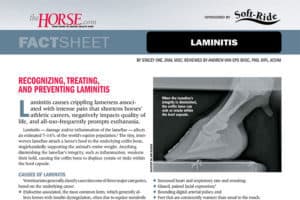
Managing Club Feet in Adolescent Horses
Recognizing and treating club feet in young horses can help them succeed in their intended discipline and, ultimately, prevent lifelong hoof complications.


Recognizing and treating club feet in young horses can help them succeed in their intended discipline and, ultimately, prevent lifelong hoof complications.

A systematic approach to examining the equine foot can help veterinarians identify causes of lameness more quickly and accurately.

The transitional period between anestrus and estrus is officially complete once a mare has had her first heat of the year. Getting some mares to this point, however, and deciding when to breed them can be tricky.

From when to administer ulcer medication to how to deal with recurring ulcers, veterinarians offer tips and tricks on managing this common horse health condition.

Consider these tips to help protect your horse’s breathing zone and most effectively achieve optimal respiratory health this winter.

Researchers tested a sulfadiazine and trimethoprim suspension specifically designed for oral administration with positive results.

Regenerative therapies can help horses recover following injury. Download this free fact sheet to learn more about stem cell, IRAP, and PRP therapy use in horses.

Laminitis causes crippling lameness associated with intense pain that shortens horses’ athletic careers. Download this fact sheet to learn more about recognizing, treating, and preventing laminitis in horses.

Magnesium, an important macromineral found in most feedstuffs, plays integral roles in muscle contraction, skeletal growth, and a variety of enzyme systems, such as those involved in energy production.

Learn about special characteristics of each part of the horse’s digestive tract and different medical conditions that can develop there.

Do all young horses with fluid-filled joints or lameness have osteochondritis dissecans (OCD)? Download this fact sheet to find out.

Equine recurrent uveitis, or ERU, remains a timely, expensive, and unrewarding disease to treat due to recurrence, loss of vision, and loss of use.

Horses are highly susceptible to botulism, which causes neurologic disease and death. Download this free fact sheet to learn more!

While either the small or large intestines are usually the focus of colic discussions, the junction of the small intestine and cecum at the start of the large intestine—the ileocecal junction—also deserves mention.

There are six main classes of corneal ulcers in horses that veterinarians must consider and properly diagnose to institute appropriate therapy.

A successful equine slim-down program includes frequent weight assessments, smart feeding techniques, and various forms of exercise.
Stay on top of the most recent Horse Health news with